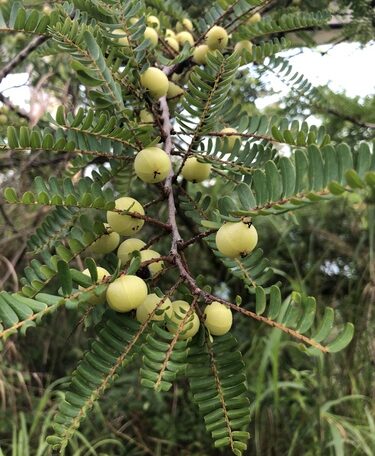Botanical name: Phyllanthus emblica| Hindi: आँवला | Marathi: आवळा | English: Indian Gooseberry
About
The Indian Gooseberry, fondly known as आँवला, आवळा, or Phyllanthus emblica, is a small, deciduous tree reaching up to 8 meters. Its green, glossy leaves resemble those of the tamarind tree. The star attraction is the gooseberry itself – a round, greenish-yellow fruit with a wrinkled surface. This versatile fruit ripens to yellow or orange and packs a surprising punch of vitamins and antioxidants.
Interesting Facts

Medicinal Uses: Ayurveda, the traditional Indian medicine system, reveres the Indian Gooseberry for its immense health benefits. Its high vitamin C content makes it a natural immunity booster. It’s also known for its anti-inflammatory, antioxidant, and digestive properties. Traditional uses include treating cough, cold, and skin disorders. However, scientific evidence remains mixed, and consulting a healthcare professional is crucial before using it medicinally.

Culture & Tradition: The Indian Gooseberry holds deep cultural significance in India. It’s associated with the goddess Lakshmi, symbolizing prosperity and well-being. Its fruits are offered in religious rituals and used in sacred amulets. In Ayurveda, it’s considered a “Tridoshic Rasayana,” balancing all three vital energies in the body. Its presence in homes signifies health and longevity.

Environmental Impact:The Indian Gooseberry contributes positively to the environment in several ways. Its strong root system prevents soil erosion. Its dense foliage provides shade and shelter for birds and animals. It’s also resistant to pests and diseases, requiring minimal pesticides. Additionally, its fruit attracts pollinators, promoting biodiversity. Overall, this versatile tree offers a healthy bounty while enhancing the natural world.

Food & Culinary usage: The Indian Gooseberry’s tart and astringent flavor lends itself to diverse culinary applications. Unripe fruits are often pickled, preserved in chutneys, or used in candies. Candied amla is a popular sweet treat. Ripe fruits are enjoyed fresh or juiced for their vitamin C boost. It also adds a unique tang to curries and dals. Dried amla powder (amchur) is a common spice, adding tartness and digestive benefits to dishes.

